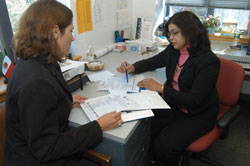Halloween has its origins in the ancient Celtic festival known as Samhain. This festival celebrated the end of the harvest season for Gaelic culture and functioned as a time to take stock of supplies and prepare for winter.
According to halloweenhistory.org, Samhain, which took place on Oct. 31 was also believed to be a time when the worlds of the living and the dead overlapped, allowing the deceased to come back to life and cause havoc on the living. This caused consequences such as sickness or damaged crops.
In order to fend off these spirits, the Gaelic people would wear masks and costumes, attempting to mimic evil spirits or appease them.
Adam Heinrich, professor of anthropology, commented on the Celtic festival. “If you look at drawings of the old costumes and masks they used to wear, they are actually quite terrifying. The people believed these masks acted as a disguise that would protect them from any evil spirits that wished to cause them harm,” said Heinrich.
He added that the first Jack- O-Lanterns were not made from pumpkins. “The Gaelic people did not have access to pumpkins so they carved faces on the ends of turnips.”
Halloweenhistory.org explained that the custom of trick-or-treating goes back to the middle ages resembling the practice of “souling,” when poor folks would go door to door on Hallomas (Nov. 1) receiving food in return for prayers for the dead on All Souls Day (Nov. 2). This custom originated in Ireland and Britain, but similar practices have been found as far as Italy.
Although a quarter million Scots-Irish immigrants came to America between 1717 and 1770, and the Irish Potato Famine brought another million in 1845-1849, trick-or-treating in America did not become widespread until generations later.
There are very few Halloween history documentations of traditions of costumes and trick-or-treating on Halloween in America before 1900 and it did not seem to become widely known until the 1930s.
The custom of trick-or-treating in America is first seen on the West coast and began to spread eastern, but it was halted by the sugar rationing that began in April 1942 during WWII and ended June 1947.
The custom of Halloween became firmly accepted as a popular holiday in 1952, when Walt Disney portrayed it in a cartoon and the United Nations International Children’s Emergency Relief Fund (UNICEF), first conducted a national campaign for children to raise funds for charity while trick-or-treating, according to halloweenhistory.org.
Today Halloween has evolved into a tradition that differs greatly from its original origins. Trick- or-treating has become a practice that is commonly referred to as begging and many children are encouraged by their parents to have their candy checked before they consume it to make sure it has not been tampered with.
Many people believe trick-or-treating is an adult invention to steer children away from violence, but there is nothing in the historical record to support these claims according to halloweenhistory.org.
Halloween has also become an excuse for young people and adults to dress up in scandalous costumes and have parties.
Sophomore Taylor Carson said, “My freshman year in high school everyone was encouraged to wear their costumes to school to celebrate Halloween and the teachers would give out candy. The next year we were given a detention if we did because girls were showing up in outfits that broke the dress code and showed way more than anyone wanted to see,” said Carson. “Teachers were also discouraged from giving candy because it was considered unhealthy.”
Freshman Kylie Johnson said she didn’t know there was a history behind costumes and Halloween. “I always assumed people got dressed up to be something else for the night. Therefore people get one night where they can show off and be whatever they want.”
Halloween is still one of the most popular holidays in American culture. According to The Huffington Post, as a country we spend over $5 billion a year celebrating and the average American spends $56.31, making it the second highest grossing commercial holiday after Christmas.
IMAGE TAKEN from just5.com




